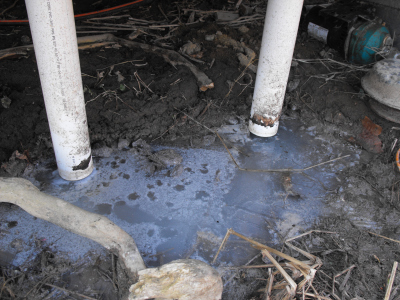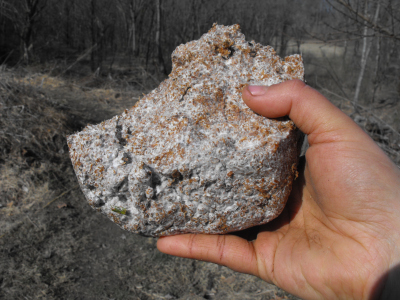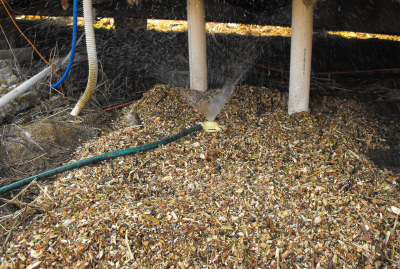
Mycoremediation with King Stropharia
 These
are our straight pipes. The operation isn't as environmentally
unfriendly as it sounds since the water only flows from our kitchen
sink, the worst pollutants are a bit of dish soap and toothpaste, and
there's no way any of it can run into the creek. Still, the
cesspool is unsightly, and Lucy likes to drink out of it, which we
highly disapprove of. Time for some mycoremediation!
These
are our straight pipes. The operation isn't as environmentally
unfriendly as it sounds since the water only flows from our kitchen
sink, the worst pollutants are a bit of dish soap and toothpaste, and
there's no way any of it can run into the creek. Still, the
cesspool is unsightly, and Lucy likes to drink out of it, which we
highly disapprove of. Time for some mycoremediation!
This is a hunk of King
Stropharia (aka Winecap) sawdust spawn. When we put in our
mushroom order this winter, I asked Mark if we could experiment with a
five pound bag of this new species. I told him how King
 Stropharia is great at filtering graywater and is also a food source
for honeybees.
But Mark still seemed displeased by my order. "Should I back off
to two pounds?"I asked. "Nope," Mark countered. "Double
it! Double it!"
Stropharia is great at filtering graywater and is also a food source
for honeybees.
But Mark still seemed displeased by my order. "Should I back off
to two pounds?"I asked. "Nope," Mark countered. "Double
it! Double it!"
Just
in case you're curious, ten pounds of King Stropharia sawdust spawn is
enough to innoculate just over a cubic yard of wood chips. I
broke the spawn down into two pound sections so that I could innoculate
several smaller beds. First, I mounded up our fresh wood
chips to a depth of
about six inches, then I crumbled up the appropriate amount of sawdust
 spawn to put on top. I covered the spawn with about an inch of
additional woodchips to protect it from drying out, then set up the
sprinkler and soaked the whole operation for a while. I'll need
to check every day for the next few weeks to make sure the mushroom
beds stay damp, watering them as necessary. Then there's no work
involved until the mushrooms appear this summer.
spawn to put on top. I covered the spawn with about an inch of
additional woodchips to protect it from drying out, then set up the
sprinkler and soaked the whole operation for a while. I'll need
to check every day for the next few weeks to make sure the mushroom
beds stay damp, watering them as necessary. Then there's no work
involved until the mushrooms appear this summer.
In addition to our
graywater filtration bed, I'm experimenting with four other
locations. Three are under the canopy of our young peach and
nectarine trees, and the fourth is out in the open but in a very damp
spot. Hopefully the spawn will take hold in at least one bed so
that next year we'll know what optimal King Stropharia habitat looks
like.
Want more in-depth information? Browse through our books.
Or explore more posts by date or by subject.
About us: Anna Hess and Mark Hamilton spent over a decade living self-sufficiently in the mountains of Virginia before moving north to start over from scratch in the foothills of Ohio. They've experimented with permaculture, no-till gardening, trailersteading, home-based microbusinesses and much more, writing about their adventures in both blogs and books.
Want to be notified when new comments are posted on this page? Click on the RSS button after you add a comment to subscribe to the comment feed, or simply check the box beside "email replies to me" while writing your comment.

Over here, people are experimenting with creating pools lined with special plants to break down contaminants in the water. This is called a helophyte filter. Plants used are e.g. Typha latifolia (cattails) or Phragmites australis (the common reed). Apparently these plants both use their hollow cores to transport oxygen to their roots, allowing aerobic bacteria to break down waste (e.g. nitrates and phophates).
If I understand correctly, almost any kind of reed will do the trick. Floating waterplants also seem to do as well. With some effort if might even look pretty nice.
For treating sewage, it seems that an extra layer of sand under the plants is necessary. The water is is supposed to flow through the roots of the plants, and then through the sand. After that it can be run off or collected for use. Here this kind of water is reckoned to be suitable for everything but drinking.
What I wonder about is what to do about mosquitos? Kitchen run-off and even sewage for a single house wouldn't be much of a stream, would it? You'd get almost stagnant water, a fine breeding ground for mozzies. Covering it up with wood chips to grow mushroom seems a much better option in that regard. Do those mushrooms also purify the water? I'd never heard of it. Quite interesting.
I've been reading up on duckweed since they're a good protein source for chickens and have read that they can filter water as well. You're right about mosquitoes being a potential problem. I'd solve it in one of two ways. If I had a lot of water, I'd turn it into a real ecosystem so that fish and other organisms in the water dealt with the mosquito larvae. But, on my scale, I think it'd be better to make a wetland without any standing water. Cattails grow just fine in marshy areas, so if you planted them in sand and ran the water through the sand around their roots, you should get filtration.
Mycoremediation is a very new field. Paul Stamets is the only person I've heard about who's studying it (or at least writing about it in the popular press.) I highly recommend Mycelium Running, which has a long section outlining his studies with using mushrooms to remove everything from coliform bacteria to heavy metals from soil and water. They seem to be very effective!
Glad to see the comments about cattails. They are a great way to clean up water and when mature you can make alcohol to run you vehicles and make heat in the winter. You can get a permit from ATF for free and stop paying the oil company for what you can grow. Go to http://www.permaculture.com/welcome for more info. Isn't the internet amazing, also it helps to have worked in the waste water field for many years. Cattails are even used by a few municipalities for their primary waste treatment. Granted it's a MUCH bigger system than you would ever need for your farm.